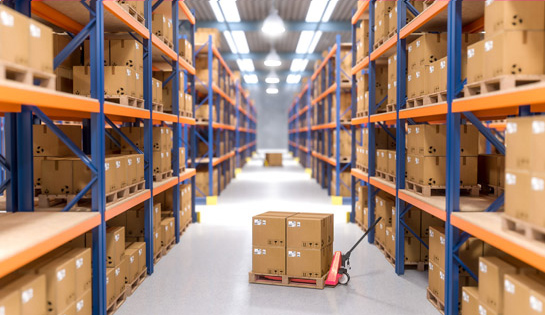How do you organize your warehouse inventory? You likely said "pallet racks". If so you're already headed in the right direction. In addition to being an easy-to-maintain warehouse storage solution, they're also the most common way to store inventory in the world.
From distribution centers and manufacturing facilities to retail operations, there is no shortage of industries that realize their practical potential. While investing in a pallet rack solution is the first step, optimizing it is the second. Have you implemented a continuous improvement process to analyze how your system is working and determine ways to make it better? For example, you may have to transition to a pick-and-pack operation from a with a simple pallet-in, pallet-out system.
In this article, we're sharing how warehouse managers can make the most use out of their storage investment. Ready to learn more? Here we go:
-

Do Your Research
Before adding racking to a warehouse, it's smart to partner with a pallet racking expert like Arbor Material Handling first. Our team can come out to your site, inspect your facility and help you determine the best way forward. Adding the wrong pallet rack configuration could put your materials and your workforce in danger. In addition to assisting with sizing requirements, a pallet rack expert can also show you how to integrate a new pallet rack into an existing storage system.
-

Maximize Vertical Space
If you want to leverage as much of your warehouse as possible for storage, remember to look up. Often, there's vertical space that's gone unused. To free extra horizontal space, stack your pallets higher, if possible. If your forklift trucks can't reach the highest shelves, a ramp solution can assist.
-

Long Rows, Not Short Bursts
A fewer number of long rows along your building's length are more efficient than lots of short rows across its width. If necessary, break up those long rows with cross-aisles, allowing workers to choose the most convenient route. Face all rows in the same direction and maximize your use of the space. This means there should be few (if any) rows that serve only one row of racking. Dynamic storage systems such as push-back racking and pallet flows allow you to increase your storage capacity while still ensuring that inventory is easy to access.
-

Account for Overhangs
For the most part, boxed products sit within the pallet's footprint. However, certain bagged goods, (such as cement) may lean and overhang. The distance between each upright is known as your racking's beam length. It's also called "clear entry" or "bay width". This number reveals the full width of the stored items that can fit within each racking space. If you measure and specify the beam length according to specific pallet widths, you'll risk it being too narrow for overhanging loads.
-

Coordinate Racking and Lift Truck
You don't want to invest in a pallet storage system only to find that the new aisles are too narrow for your forklift. While that's an inefficient use of your space, the opposite also holds true. Too-wide aisles mean that you aren't using your warehouse to its top capacity. Ideally, your racking suppliers and forklift truck operators should coordinate to find a measurement that fits. Remember: Your truck should be able to reach into the full depth of your deepest rack. It should also be able to lift and reach the top level.
-

Don't Be Afraid to Reconfigure
The pallet rack solution that worked for your warehouse 5 years ago might be inefficient now because your enterprise has grown, or you realize that you aren't using your mega-sized layout to its full capacity and it's time to downsize. Either way, it's smart to implement a continuous improvement process to analyze how your system is working and determine ways to make it better. For instance, you might have started out a few years ago with a simple pallet-in, pallet-out approach in your retail space. Ten years later, you realize it's smarter to adopt a pick-and-pack operation to keep pace with e-commerce demands and organize a wider variety of SKUs. Watch and discuss market trends with your warehouse team so you're prepared to ride any wave that comes your way. Whether you install a new racking system or reconfigure an existing one, add extra capacity into it to accommodate future growth.
-

Keep Specifications Realistic
Especially if you're buying used pallet rack, it's common to purchase over-specified racking that's capable of holding far more weight than you'll ever need. Figure out what you'll really require, and look for racks that fit within that range. The key metric to keep in mind is Universally Distributed Load (UDL), or Safe Working Load (SFL). This defines the weight that a pair of beams can support. In general, beam costs and capacities scale together. At the same time, be careful not to under-specify your load requirements. Doing so can render them incapable of keeping up with demand, leading to a weakened infrastructure or collapse.
-

Move Your Lowest Beam Up
When workers go to lift goods out of racking from the floor level, they have to raise the pallet load up and over the lift truck's reach leg, being careful not to hit the beam above. To make this process easier, add a little extra distance between the ground and the first beam. Ideally, aim for around 300 mm more than the space between the other beams in the bay, if possible.
-

Professional Pallet Rack Advice You Can Trust
Optimizing your pallet rack layout for maximum storage capacity doesn't have to become an operational challenge. With the right tools and resources, you can invest in a solution that maximizes your investment, turning your warehouse into an efficient material handling space. Need someone to help you design, build, improve or repair your pallet rack system? That's where we come in. We're industry experts committed to helping warehouse and distribution center professionals understand the best practices to use. Contact us today for the trusted advice you need.
Still have questions about organizing your warehouse inventory and making the most of their storage investment? Fill out the form below and we will get back to you to to offer assistance!

